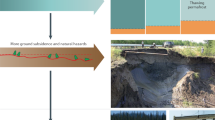The threat to man-made structures across regions in the far north can be monitored.
Abstract
The thawing and disappearance of permafrost has accelerated in recent decades1, damaging buildings and infrastructure and causing public concern2. Here we offer a geographic overview of the hazard potential associated with thawing permafrost in the Northern Hemisphere which indicates that vulnerability to subsidence is widespread. Much of the existing infrastructure erected in northern regions is located in areas of high hazard potential and could be affected by thaw subsidence under conditions of global warming.

Similar content being viewed by others
References
Serreze, M. C. et al. Climatic Change 46, 159–207 (2000).
Linden, E. Time 156, 52–56 (2000).
Kattenberg, A. et al. in Climate Change 1995: The Science of Climate Change. Contribution of Working Group I to the Second Assessment Report of the Intergovernmental Panel on Climate Change (eds Houghton, J. J. et al.) 285–357 (Cambridge Univ. Press, New York, 1996).
Greco, S. et al. & IPCC Working Group II. Climate Scenarios and Socioeconomic Projections for IPCC WG II Assessment (Consortium for International Earth Science Information Network, Washington DC, 1994).
Anisimov, O. A., Shiklomanov, N. I. & Nelson, F. E. Glob. Planet. Change 15, 61–77 (1997).
Staub, B. & Rosenzweig, C. Global Gridded Data Sets of Soil Type, Soil Texture, Surface Slope and Other Properties (National Center for Atmospheric Research, Boulder, CO, 1987). URL: http://www.ngdc.noaa.gov/seg/eco/cdroms/ged_iia/datasets/a11/sr.htm#top
Brown, J., Ferrians, O. J. J., Heginbottom, J. A. & Melnikov, E. S. International Permafrost Association Circum-Arctic Map of Permafrost and Ground Ice Conditions (scale 1:10,000,000, US Geological Survey Circum-Pacific Map Series, Map CP-45, Reston, VA, 1997). URL: http://www.geodata.soton.ac.uk/ipa/
Monmonier, M. Cartographies of Danger: Mapping Hazards in America (Univ. Chicago Press, 1997).
Anisimov, O. A. & Nelson, F. E. Climatic Change 35, 241–258 (1997).
Riseborough, D. W. in Proc.Fifth Canadian Permafrost Conf. (eds Burgess, M. M., Harry, D. G. & Sego, D. C.) 199–205 (Centre d'études nordiques, Université Laval/National Research Council of Canada, Québec, 1990).
Parmuzin, S. Y. & Shamanova, I. I. Polar Geogr. Geol. 10, 184–193 (1986).
US National Imagery and Mapping Agency. Digital Chart of the World for ADOL (ESRI, Inc., Redlands, CA, 1997). URL: http://www.esri.com/data/online/esri/wobmselect.html
Scripter, M. W. Ann. Assoc. Am. Geogr. 60, 385–393 (1970).
Author information
Authors and Affiliations
Corresponding author
Rights and permissions
About this article
Cite this article
Nelson, F., Anisimov, O. & Shiklomanov, N. Subsidence risk from thawing permafrost. Nature 410, 889–890 (2001). https://doi.org/10.1038/35073746
Issue Date:
DOI: https://doi.org/10.1038/35073746
- Springer Nature Limited
This article is cited by
-
Future transitions from a conifer to a deciduous-dominated landscape are accelerated by greater wildfire activity and climate change in interior Alaska
Landscape Ecology (2023)
-
Permafrost degradation increases risk and large future costs of infrastructure on the Third Pole
Communications Earth & Environment (2022)
-
Impacts of permafrost degradation on infrastructure
Nature Reviews Earth & Environment (2022)
-
Framework for economic cost assessment of land subsidence
Natural Hazards (2021)
-
CMIP6 model projections leave no room for permafrost to persist in Western Siberia under the SSP5-8.5 scenario
Climatic Change (2021)





